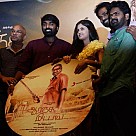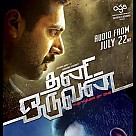“Baahubali, The Beginning” is already shattering box office records as the ‘largest Indian motion picture’ in making and marketing to date. The film is being celebrated as a package of cutting edge CGI, majestic background music, striking costumes and strong performances from a memorable cast, particularly those of the fiery Ramya Krishnan and Sathyaraj.
But all the while, I continue to see some reviews and commentary that encourage people to ‘lower their expectations for the story’ and/or simply to enjoy the film as an exhibition of hard work and originality in creative production, but not necessarily creative writing.
So I’m here to challenge those common complaints I keep seeing amidst audiences for Baahubali so far; I’m here to say that like many of us may have underestimated Prince Baahubali’s initial strategies of war during the film’s climax, we may be underestimating the cunning set up of Baahubali as a 2-part epic, and being overly critical of a film that actually engages both our senses and minds in a non-typical fashion. Because Baahubali is a true epic in its own right, and has set a high standard that many will not be diligent enough to attempt for a long time, unless we encourage them to do so.
Complaint #1: Typical revenge storyline
I don’t think ‘typical’ is a fair descriptor of Baahubali’s storyline at all. A simplistic or typical, royal, revenge story would have pivoted on an antagonist unfairly claiming the throne early on, and a benevolent leader out to save his kingdom. Here, we are treated to an a-typical origin story and the interesting concept of a lifelong competition of strength & worthiness amongst princes for the throne. Although the set up of this film will undoubtedly culminate in a story of ultimate revenge in the sequel I must oppose the classification of Baahubali, The Beginning as relying purely on its looks and not an original story beneath it.
In fact, as a small example of this depth, I was pleasantly surprised that the climax battle of the film, which was certainly SS Rajamouli’s peak of artistic brilliance, stimulated our minds beyond just our senses! Unlike the climax fights of most other Tamil films these days, our brainpower was actually required to appreciate Rajamouli’s interpretation of ancient Indian war tactics and we had both visuals as well as clever surprises to take in.
Complaint #2: “No heart”
What does ‘no heart’ even mean? Is it because the characters, despite all their turmoil, didn’t cry much? Was it because the love story within it was not weepy?
I saw ‘heart’ in the beautifully executed scenes where kingdoms found strength in chanting the name of their fallen leader while being beaten. Or when a truly rocking, but also menacing, female leader (played stunningly by the one and only Ramya Krishnan) broke all ‘evil Queen’ archetypes and ruled with a fair hand and deadly sword-wielding skills. Or when the bonds between servants and royalty were marred by affection. Or when a captivating lead hero, played memorably by the handsome Prabhas, lights a fire under his defeated troops with a powerful speech on the battleground.
‘Heart’ in a film, to me, is when characters move you, but there’s no rule that says they have to do so through melancholy or waterworks. Baahubali is chalk full of heart, from Sivagami to Kattappa to Avanthika to the nameless guards and villagers; perhaps the sentiments are just lost to some amidst Rajamouli’s massive grandeur. Gone are the days when characters had to wail about their despair – Baahubali proves that heart can just as clearly lie in battle cries.
Complaint #3: Too long
Baahubali was marketed as an epic, so we knew right from the start that it would be a ~ 3 hour affair. It was also created with the public intention to be a 2-part film so we also knew that it would end on a cliffhanger. Some have complained that the ‘flashback’ portion of the epic could have been wrapped up within part 1 itself, but I beg to ask why it is such an issue if the past and present portions of the story are not so clearly cut and dry between the 2 films. I thought we audiences appreciated the unexpected, and non-formulaic and non-conforming? In my opinion, Rajamouli made a genius move to stop the story right where he did at the end of part 1 – with a truly unpredictable and confusing plot twist – and had he finished the flashback within part 1 we may have had very little (meaning purely a typical revenge story, that we all seem to be tired of) to look forward to in part 2!
Aside from some portions of extended battle scenes, I never found the film to lag; in comparison to the rest of commercial South Indian films we see these days where unrelated comedy tracks and at least 3-4 fantasy song sequences take up a good 40% of the film, Baahubali is a tightly packaged adventure that focuses on proper lead role development, and doesn’t waste time on unnecessary characters. Aside from the ‘Pachchai’ and ‘Manohari’ songs, which could be considered the film’s only true mass indulgences, Baahubali stays focused and packs a lot into its 2 hours and 40 minutes!
There are few films these days that I feel actually need a sequel, but I am truly looking forward to Baahubali’s part 2, because I think Rajamouli’s ‘war strategies of cinema’ are ones worthy of true celebration. It’s high time we more thoughtfully appreciate the massive amount of efforts, in production and storytelling that go into epics like Baahubali, because appreciation is encouragement and without it we have no reason to complain when filmmakers and studios avoid attempting epic feats of cinema like this in the future.












